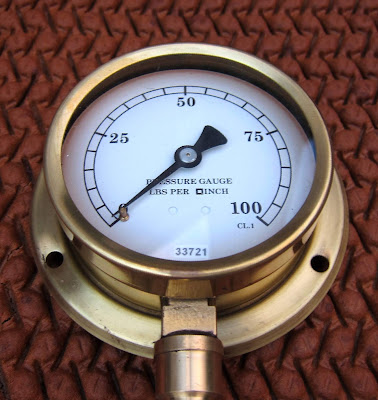Following on from 'Steam Heating (1)', this is how it's developed.
What equipment is needed?
1. High pressure pipework and an isolating valve able to withstand the Sentinel boiler temperature & pressure (212DegC & 275psi).
 |
| High Pressure Pipe Fittings and Valve |
The second union below the 'T' fitting allows the valve to be orientated appropriately. The valve is a three-part ball valve made by Valtac. I've written about these before. The hex nipple below the valve will connect to flexible braided hose to take the steam down to the buffer beam. Although the nipple in the photo is a steel type, I will be using a parallel threaded hydraulic fitting machined to take a copper washer sealed mating connector.
2. Pipework to carry the boiler pressure steam to the buffer beam apparatus.
Purists might criticise me for using modern flexible stainless steel braided hose instead of copper pipe with braized end fittings. I can order and receive the flexible hose with welded end fittings and a pressure test certificate within a week and be confident in the result. Using copper pipe, I cannot do this. (In fact, the hose arrived in four days!).
I've covered this before in detail here.
3. A pressure reducing valve to take the boiler pressure down to the carriage requirements (about 40psi).
 |
| Blue Pressure Reducing Valve (centre) (and one assistant) |
 |
| Blue Pressure Reducing Valve (and other assistant) |
Arguably, to reduce the length of high pressure hose, I could have put the pressure reducing valve below the ball valve instead of behind the buffer beam. However the PRV needs to be mounted upright and would have taken up too much space in the cab.
4. A safety valve to prevent exceeding the carriage maximum pressure.
 |
| Gunmetal Safety Valve |
 |
| Safety Valve Detail including 3 bar setting. |
 |
| 3" Steam Pressure gauge |
6. Heavy duty bracketry to fix the pipework and standard buffer beam equipment to the buffer beam itself.
 |
| Flange made to fit the standard buffer beam equipment to the buffer beam |
 |
| The flange 3-point mounting to the rear buffer beam |
I've pre-assembled the 'flat-pack' version of the equipment to show it all together before it disappears out of sight in and under Joyce's metalwork.
 |
| Complete 'flat-pack' and assistants |
Now all I have to do is fit the kit and test it. Initial fitting will be quite quick for test purposes. I'll clamp the pipework properly when I'm happy it performs satisfactorily. The assistants will not be allowed on site at Midsomer Norton as they haven't passed their Personal Trackside Safety exam (honest!).
No comments:
Post a Comment